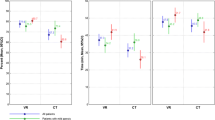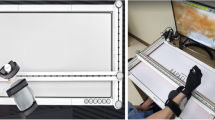Abstract
Task-specific training has been proven to be effective in promoting recovery of the hemiparetic upper extremities after a stroke. This study was to develop a task-specific VR (TS-VR) program using a leap motion controller device and the Unity3D game engine to promote recovery of the hemiparetic upper extremity in patients with stroke based on a hierarchy of seven functional tasks in the functional test for the hemiplegic upper extremity (FTHUE). The final version of the TS-VR was tested on 20 patients suffering from chronic stroke with upper-extremity hemiparesis over 2 weeks, 5 sessions per week, 30 min per session. Outcomes were assessed using the Fugl-Meyer assessment-upper extremity score (FMA-UE), the Wolf motor function test (WMFT), and the motor activity log (MAL) at the first (week 0), last (week 2), and follow-up sessions (week 5). Patients’ arm impairments were stratified into lower (levels 1–4) and higher (levels 5–7) functioning groups according to the FTHUE. Significant improvements were found after TS-VR training in FMA-UE total score and its subscores, and WFMT score among the three time occasions (p = 0.000), but no significant effect on grip strength was found. The higher-functioning group benefited more from the TS-VR, as indicated in outcome measures as well as amount of use score in MAL, but this was not the case for those in the lower-functioning group. Our findings show the TS-VR training was useful for upper-extremity recovery in patients with chronic stroke. It has potential to be applied in clinical settings in future.



Similar content being viewed by others
Data availability
The datasets generated during and/or analyzed during the current study are available from the corresponding authors on reasonable request.
Abbreviations
- AR:
-
Augmented reality
- FMA-UE Total:
-
Fugl-Meyer assessment-upper-extremity total score
- FMA-UL:
-
Fugl-Meyer assessment-upper limb subscore
- FMA-Hand:
-
Fugl-Meyer assessment hand subscore
- FTHUE:
-
Functional test for the hemiplegic upper extremity
- Group 1:
-
Higher-functioning group
- Group 2:
-
Lower-functioning group
- LMC:
-
Leap motion controller
- MAL-AOU:
-
Motor activity log-amount of use scale (AOU)
- MAL-QOM:
-
Motor activity log-quality of movement scale (QOM)
- TS-VR:
-
Task-specific virtual reality program
- WMFT:
-
Wolf motor function test
- VR:
-
Virtual reality
References
Bayona NA, Bitensky J, Salter K, Teasell R (2005) The role of task-specific training in rehabilitation therapies. Top Stroke Rehabil 12(3):58–65
Bohannon RW, Smith MB (1987) Interrater reliability of a modified Ashworth scale of muscle spasticity. Phys Ther 67:206–207
Borschmann KN, Hayward KS (2020) Recovery of upper limb function is greatest early after stroke but does continue to improve during the chronic phase: a two-year, observational study. Physiotherapy 107:216–223. https://doi.org/10.1016/j.physio.2019.10.001
Cauraugh JH, Kim SB (2003) Stroke motor recovery: active neuromuscular stimulation and repetitive practice schedules. J Neurol Neurosurg Psychiatry 74(11):1562–1566
Colgan A (2017) How does the leap motion controller work?. Leap Motion Blog. Available from:. http://blog.leapmotion.com/hardware-to-software-how-does-the-leap-motion-controller-work/
Condino S, Turini G, Viglialoro R, Gesi M, Ferrari V (2019) Wearable augmented reality application for shoulder rehabilitation. Electronics 8(10):1178. https://doi.org/10.3390/electronics8101178
Cortés-Pérez I, Zagalaz-Anula N, Montoro-Cárdenas D, Lomas-Vega R, Obrero-Gaitán E, Osuna-Pérez MC (2021) Leap motion controller video game-based therapy for upper extremity motor recovery in patients with central nervous system diseases: a systematic review with meta-analysis. Sensors 21:2065. https://doi.org/10.3390/s21062065
Cunningham P, Turton AJ, Van Wijck F, Van Vliet P (2016) Task-specific reach-to-grasp training after stroke: development and description of a home-based intervention. Clin Rehabil 30(8):731–740
De Mauro A (2011) Virtual reality based rehabilitation and game technology. Eng Interact Comput Syst Med Healthc 1:48–52
Dobkin BH (2005) Clinical practice. Rehabilitation after stroke. N Engl J Med 352(16):1677–1684
Duncan PW, Propst M, Nelson SG (1983) Reliability of the Fugl-Meyer assessment of sensorimotor recovery following cerebrovascular accident. Phys Ther 63(10):1606–1610
Fernández-González P, Carratalá-Tejada M, Monge-Pereira E et al (2019) Leap motion controlled video game-based therapy for upper limb rehabilitation in patients with Parkinson’s disease: a feasibility study. J NeuroEng Rehabil 16:133. https://doi.org/10.1186/s12984-019-0593-x
Fong K, Ng B, Chan D et al (2004) Development of the Hong Kong version of the functional test for the hemiplegic upper extremity (FTHUE-HK). Hong Kong J Occup Ther 14:21–29
Fong KNK, Chow KKY, Chan BCH, Lam KCK, Lee JCK, Li THY, Yan EWH, Wong AKY (2010) Usability of a virtual reality environment simulating an automated teller machine for assessing and training persons with acquired brain injury. J Neuroeng Rehabil 7(19):1–9
Fong KNK, Lo PCP, Yu YSY, Cheuk CKL, Tsang THT, Po ASS, Chan CCH (2011) Effects of sensory cueing on voluntary arm use for patients with chronic stroke: a preliminary study. Arch Phys Med Rehabil 92(1):15–23
Fugl-Meyer AR, Jaasko L (1980) Post-stroke hemiplegia and ADL performance. Scand J Rehabil Med 7:140–152
Fugl-Meyer AR, Jääskö L, Leyman I, Olsson S, Steglind S (1975) The post-stroke hemiplegic patient. 1. A method for evaluation of physical performance. Scand J Rehabil Med 7(1):13–31
Galea MP, Miller KJ, Kilbreath SL (2001) Early task-related training enhances upper limb function following stroke. In: Poster presentation (March 25–30, 2001) at the annual meeting of the society for neural control of movementvi. Sevilla, Spain
Ghassemi M, Triandafilou K, Barry A et al (2019) Development of an EMG-controlled serious game for rehabilitation. IEEE Trans Neural Syst Rehabil Eng 27(2):283–292. https://doi.org/10.1109/TNSRE.2019.2894102
Hossain MS, Hardy S, Alamri A et al (2016) AR-based serious game framework for post-stroke rehabilitation. Multimedia Syst 22:659–674. https://doi.org/10.1007/s00530-015-0481-6
Kiper P, Szczudlik A, Agostini M et al (2018) Virtual reality for upper limb rehabilitation in subacute and chronic stroke: a randomized controlled trial. Arch Phys Med Rehabil 99:834–842
Krastev G, Andreeva M (2015) A software tool for experimental study leap motion. Int J Comput Sci Inf Technol 7(6):145–153
Kwakkei G, Kollen BJ (2013) Predicting activities after stroke what is clinically relevant? Int J Stroke 8:25–32
Lee B, Lee D, Chin S (2018) Structural motion grammar for universal use of leapmotion: amusement and functional contents focused. J Sens 6073786:1–15
Magill RA, Anderson DI (2007) Motor learning and control: concepts and applications, vol 11. McGraw-Hill, New York
Ng AKY, Leung DPK, Fong KNK (2008) Clinical utility of the action research arm test, wolf motor function test and the motor activity log of hemiparetic upper extremity functions after stroke: a pilot study. Hong Kong J Occup Ther 18(1):20–27
Okazaki S, Muraoka Y, Suzuki R (2017) Validity and reliability of leap motion controller for assessing grasping and releasing finger movements. J Ergon Technol 17(1):32–42
Page SJ (2003) Intensity versus task-specificity after stroke: How important is intensity? Am J Phys Med Rehabil 82(9):730–732
Renganayagalu SK, Mallam SC, Nazir S (2021) Effectiveness of VR head mounted displays in professional training: a systematic review. Tech Know Learn. https://doi.org/10.1007/s10758-020-09489-9
Saposnik G, Levin M, Stroke Outcome Research Canada (SORCan) Working Group (2011) Virtual reality in stroke rehabilitation: a meta-analysis and implications for clinicians. Stroke 42(5):1380–1386
Seo NJ, Kumar JA, Hur P, Crocher V, Motawar B, Lakshminarayanan K (2016) Usability evaluation of low-cost virtual reality hand and arm rehabilitation games. J Rehabil Res Dev 53(3):321–334
Shin JH, Kim MY, Lee JY et al (2016) Effects of virtual reality-based rehabilitation on distal upper extremity function and health-related quality of life: a single-blinded, randomized controlled trial. J NeuroEng Rehabil 13(1):17
Syberfeldt A, Danielsson O, Holm M, Wang LH (2015) Visual assembling guidance using augmented reality. Procedia Manuf 1:98–109. https://doi.org/10.1016/j.promfg.2015.09.068
Tang YM, Au KMK, Leung Y (2018) Comprehending products with mixed reality (MR): geometric relationships and creativity. Int J Eng Bus Manag 10:1–12. https://doi.org/10.1177/1847979018809599
Tang YM, Au KM, Lau HCW et al (2020a) Evaluating the effectiveness of learning design with mixed reality (MR) in higher education. Virtual Real 24:797–807. https://doi.org/10.1007/s10055-020-00427-9
Tang YM, Ng GWY, Chia NH, So EHK, Wu CH, Ip WH (2020b) Application of virtual reality (VR) technology for medical practitioners in type and screen (T&S) training. J Comput Assist Learn. https://doi.org/10.1111/jcal.12494
Timmermans AA, Seelen HA, Willmann RD, Rakx W, de Ruyter B, Lanfermann G, Kingma H (2009) Arm and hand skills: training preferences after stroke. Disab Rehabil 31:1344–1352
Turolla A, Dam M, Ventura L et al (2013) Virtual reality for the rehabilitation of the upper limb motor function after stroke: a prospective controlled trial. J Neuroeng Rehabil 10:85
Uswatte G, Taub E, Morris D, Light K, Thompson PA (2006) The motor activity log-28: assessing daily use of the hemiparetic arm after stroke. Neurology 67:1189–1194
Wang ZR, Wang P, Xing L, Mei LP, Zhao J, Zhang T (2017) Leap motion-based virtual reality training for improving motor functional recovery of upper limbs and neural reorganization in subacute stroke patients. Neural Regen Res 12(11):1823–1831. https://doi.org/10.4103/1673-5374.219043
Wei WXJ, Fong KNK, Chung RCK, Cheung HKY, Chow ESL (2019) “Remind-to-move” for promoting upper extremity recovery using wearable devices in subacute stroke: a multicenter randomized controlled study. IEEE Trans Neural Syst Rehabil Eng 27(1):51–59
Weichert F, Bachmann D, Rudak B, Fisseler D (2013) Analysis of the accuracy and robustness of the leap motion controller. Sensors 13(5):6380–6393
Wilson DJ, Baker LL, Craddock JA (1984) Functional test for the hemiplegic upper extremity. Am J Occup Ther 38:159–164
Wolf SL, Thompson PA, Morris DM, Rose DK, Winstein CJ, Taub E et al (2005) The EXCITE trial attributes of the wolf motor function test in patients with subacute stroke. Neurorehabil Neural Repair 19:194–205
Acknowledgements
The authors would like to express their appreciation to the Hong Kong Stroke Association for coordinating the data collection.
Funding
The study received no funding from any source.
Author information
Authors and Affiliations
Contributions
KNKF designed the study. YMT and KS were responsible for the technical parts, including modeling the virtual content, computer programming, and development of the TS-VR program. KS, AKHY, CCWL, and YWTM were primarily responsible for the data collection, and data analysis. KNKF, YMT, KS, AKHY, CCWL, and YWTM drafted the manuscript. All authors made substantial contributions to the manuscript, and all read and approved the final version.
Corresponding author
Ethics declarations
Conflict of interest
The authors declare that they have no competing interests with respect to the research, authorship, and/or publication of this article.
Ethics approval
The study was carried out in accordance with the principles of the Declaration of Helsinki. Ethical approval was sought and obtained from the Human Ethics Committee of the Hong Kong Polytechnic University (HSEARS20180503002).
Consent to participate
Written and informed consent was obtained from all patients before the study commenced.
Consent for publication
Use of data and materials for purposes of reporting was included in the informed consent procedures and all patients gave their written consent for this publication.
Additional information
Publisher's Note
Springer Nature remains neutral with regard to jurisdictional claims in published maps and institutional affiliations.
Rights and permissions
About this article
Cite this article
Fong, K.N.K., Tang, Y.M., Sie, K. et al. Task-specific virtual reality training on hemiparetic upper extremity in patients with stroke. Virtual Reality 26, 453–464 (2022). https://doi.org/10.1007/s10055-021-00583-6
Received:
Accepted:
Published:
Issue Date:
DOI: https://doi.org/10.1007/s10055-021-00583-6




